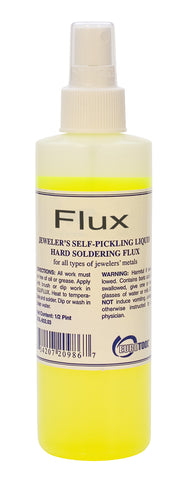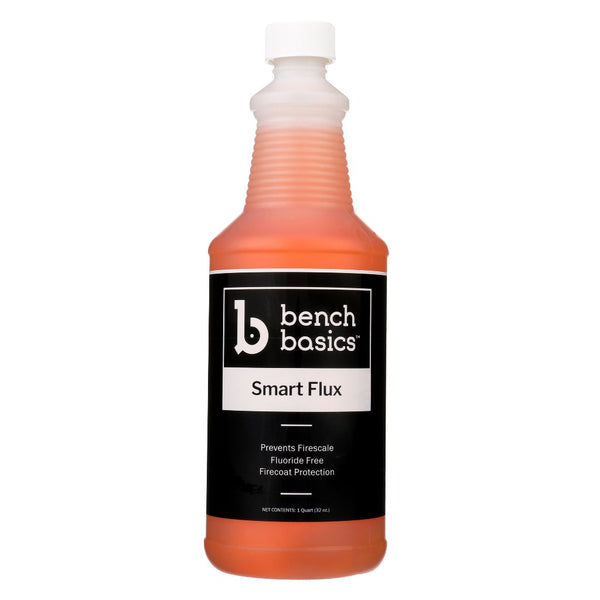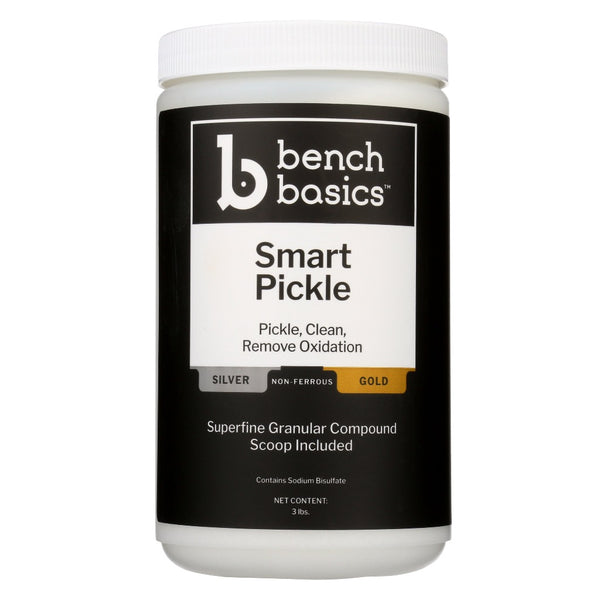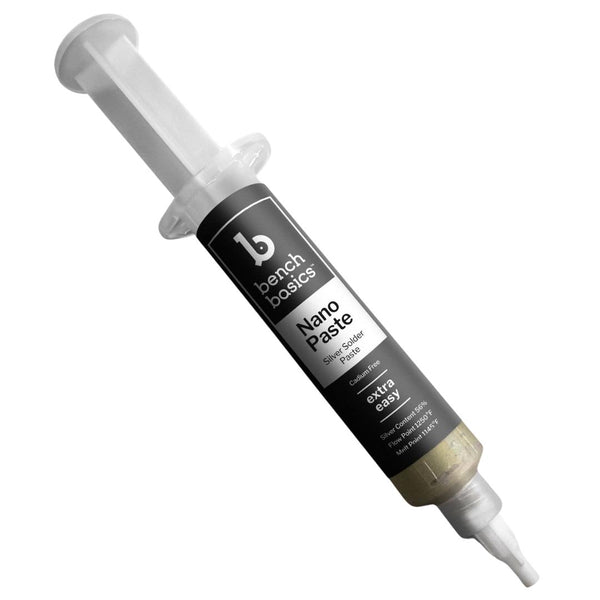Traditional method - Borax
The traditional method used by jewelers is a Borax cone. You may have seen these for sale and wondered what they are for. The borax cone is used to make your own flux. Essential with the cone is an unglazed ceramic dish (Borax dish). Place a few drops of water in the dish and rub the cone around the dish, with a grinding action, just for a few seconds. As you do so, the rough surface of the dish causes microscopic particles of the borax cone to grind off and combine with the water to form a white milky paste - flux. A small paintbrush is used to apply the flux along the joint to be soldered.
Tip: - a small plastic bottle with a nozzle (as used with hair dye), is perfect for applying a few drops of water into the dish.

With so many “ready to use” fluxes now available you may wonder why so many jewelers continue to use this traditional method. There are two main advantages: - firstly a borax cone is just a couple of dollars and even with regular use can last several years. So, it's virtually no cost. The other big advantage is that you can vary the consistency. The more you grind the cone, the thicker the paste will become. Likewise, adding just a couple of drops more water to the dish will dilute the flux. Imagine soldering a large piece such as a wide cuff bangle, you may want the flux a little thicker so that it stays in place along the seam. Conversely, there may be times when you want the solder to flow into and around a piece, such as soldering the ends of a chain into a chain end fitting or fixing a bezel to a flat sheet. In this case, a thinner flux will give better coverage and help the solder flow into these tight areas.
As the Silver (with Borax flux applied) is heated, you will see three stages.
- Boiling
As you apply heat to the silver. Firstly, the water in the flux will boil away.
Tip: - As the flux boils, this can knock off your pieces of solder. So dry the flux first with a very gentle flame, and then apply the solder.
- Blossoming
Once dried the flux will then “Blossom”, this is the borax recrystallizing on the surface of the silver. The effect is the sudden appearance of small white crystals growing on the surface. Hence the term blossoming, as it looks like blossom sprouting on the silver.
- Brown Glassy
Continuing to apply heat, the white blossom will melt and turn into a brown glassy film. The solder will now melt and flow where the flux has been painted.
Tip: - Remember to apply flux to your solder pieces too. Using the flux brush to pick up and apply small pieces of solder to the silver.
Borax is suitable for most soldering jobs with silver and gold, it's quick, cheap, and easy. Whilst it does require a little practice to master, it is a vital skill for any new jeweler to learn and is the most valuable skill you can have.

Pre-made, ready to use Flux. Note the fluorescent yellow color.
Pre-made fluxes.
There are many premade flux solutions on the market. These come in convenient liquid form, typically a thin, bright yellow fluorescent liquid. Most can simply be used right out of the bottle. Apply with a small brush painting the liquid directly to the piece and the solder. As the flux is liquid, you can't control the consistency, so care must be anywhere it runs, to ensure correct coverage, without overspill. Some specialist fluxes are intended for silver, some for gold, and some for platinum which requires a higher temperature. But for general jewelry work with silver and gold, an all-purpose flux will cover most of your needs.
The big advantage of premade fluxes is the convenience of a ready-to-go solution. Another big advantage is that the whole piece (e.g., a chain) can be dunked into a jar of liquid flux, then lightly heated with a flame to dry it. a couple of repeated dunks will coat the entire piece in flux, allowing every link to then to be soldered. When grinding borax, you typically only make a small amount of flux in the dish, it isn’t possible to make a jar full which you can dunk a large piece in. So, a bottle of premade flux is a real advantage when you want to immerse a piece. Such as when annealing a large coil of wire.
tip:- you can also use liquid flux in a small spray bottle (eg travel perfume ). And spray it onto the piece for more coverage. Ideal for annealing.

In use, the premade fluxes act in the same way. Apply straight from the bottle with a paintbrush directly to the piece, spray, or dunk. Remember to apply a drop of flux onto your solder too. As before, you will see the flux, boil, blossom, and then turn glassy. Although this may not be quite as visible as with borax. Again, you should be careful that your solder pieces don’t fly away. You may prefer to dry the flux out first with a soft flame and then apply the solder pieces.
Fire scale.
Sterling silver, can be prone to fire scale. When overheated in one spot, a reaction occurs with the copper in the sterling alloy which comes to the surface and oxidizes. The result is a dark shadow on the finished silver piece, which cannot be polished out. If you’re lucky, it is just superficial and can be sanded away and repolished. But often this dark staining cannot be removed by any amount of polishing. This is a common issue for beginners as they apply too much heat when learning to solder or anneal. The stained piece must be plated, or textured to hide the fire scale, or simply scrapped. However, flux can prevent this problem from occurring in the first place, by blocking the oxygen from getting to the silver. When annealing it is best practice to cover the piece in flux before heating. If you are annealing large coils of wire, it may be helpful to buy premade liquid flux and place it in a wide jar or bowl. Immerse the coil in the flux, before heating and annealing, to prevent fire scale occurring.
Don’t want to use flux at all?
Flux is a vital component of any Jewellery soldering. But there is a new option. Solder paste. (See our blog on soldering). These are special solders in silver and gold which come supplied in small syringes as a paste. The paste contains microscopic particles of solder combined with a binder and flux. The paste is simply applied to the joint and heated until the solder flows. No additional solder or flux is required. But the piece must still be clean and close-fitting. It is important to spread the paste all along the joint on both sides. When it is heated (gently!) it will clean and flux the joint before the solder particles melting.

Tip: - In some cases, It may still be advantageous to additionally flux the joint, as the silver could oxidize before the paste has had time to fully work. This results in the past burning, leaving a black residue and the solder not flowing.
Removing the flux - Pickling
After the piece has been soldered and quenched. You will see traces of the flux still on the piece. This will be seen as hard brown glassy droplets. The issue is that this dried-on flux is immensely tough to remove by normal polishing or sanding. The simple way to remove it is by immersing the piece in acid. This process is known as pickling.
“Pickle” is simply a term used to describe the acid which is used to remove the dried flux. It also has the advantage of removing tarnish and helping to clean a piece. Some jewelers purchase industrial sulphuric acid. This works very quickly, however, this usually requires permits to purchase and strict regulations on its storage. It can also be very expensive to transport when purchased and requires very careful handling and use.
Don’t be intimidated, by the thought of using acid. Whilst any such chemicals should be used with correct safety precautions. They are immensely useful and there are many products, which when used properly are perfectly safe and ideal for the jeweler.
Citric Acid.
At the entry-level, you may see a “food grade” pickle. This is simply commercially produced Citric Acid, - the same thing found in lemons and “Citrus” fruits. It is made for use in fizzy drinks and sweets. It is supplied as a dry white powder that is mixed with water to make the weak citric acid solution. As this is effectively strong lemon juice, it's harmless and safe when used properly. However, it does tend to be rather weak and so takes longer to dissolve the flux. For many hobbyists working at home with pets and children. This food-grade option is the safest solution. Many are happy to trade off performance for safety.
Tip:- Although Citric Acid is used in the food industry when mixed strong for pickling it is not intended for consumption. Always follow the manufacturer's instructions when making up and disposing of the solution. General safety such as Eye protection, gloves, and mask are always recommended when working with any chemicals.

Safety Pickle (powder)
Most of the professional products are described as safety pickles. Supplied as a dry white granular powder, (looking like sugar !) they are mixed with water to form a weak acid solution. As these are designed for jewelry use, these typically work much better and faster than the food-grade options. The solution is more corrosive and will eventually rot fabric and clothing. Pieces should be rinsed in water after pickling. If the usual safety procedures are followed, safety pickle is an easy and inexpensive option and poses no great risks. Offering great performance, in a cheap and easy to use the product.

Typical example of a small commercial pickle pot.
With a plastic inner liner and electric heater.
These work well, but can be very costly.
Pickle pots.
For safety reasons the commercial pickles above, are usually quite weak. To speed up the removal of oxide and flux, they are used warm. Special pickle pots can be purchased which heat the pickle in plastic or ceramic containers. But most jewelers prefer to use small electric slow cookers or small “Crock Pots”. Designed for cooking stews, these ceramic pots have a low power heating element and will keep the pickle warm, which greatly increases its speed. readily available and very cheap, Many companies even sell these stew crock pots as specialist jewelers pickle pots. So do shop around for the best deal. Keep this just for jewelry use, and never use it for food. Often just a few seconds in the hot pickle is all that is required to completely clean your silver of oxide and flux after soldering.

A cheap mini `Crock pot, electric food cooker.
Ideal for use as a pickle warmer.
Tip;- make and store extra pickle solution in a marked plastic bottle. As the pickle pot is hot, the pickle slowly evaporates throughout the day. Top it up, with the fresh solution as required.
Tip- depending on what you do, ensure your pickle pot (slow cooker, crockpot) is large enough to accommodate a large bangle or coil of wire.
Anti-flux.
Flux is essential for your solder to flow. But what do you do when you don’t want the solder to flow? This may sound crazy but imagine soldering a chain end onto a chain. You want the solder to flow into the chain end and around the last link, but you don’t want it to track along the chain and ruin it. So how do we stop the solder from flowing along the chain? Many things can be used to block the flow of solder. I have heard of some jewelers using typists’ correction fluid (Tippex, liquid paper), which can be painted onto the silver and will block the solder from flowing when heated.

Small pot of Rouge powder
Dave’s top tip: - Rouge powder
My tip is rogue powder. Not to be confused with women's makeup, This can be purchased from most jewelry suppliers. It comes in small pots as a very fine red powder. It is used in dry barrelling machines to polish, jewelry with crushed walnut shells. Alternatively, it can be rubbed onto metal using a soft cloth as a dry polish.
But mixed with a few drops of water on a paintbrush, it can be painted onto your silver, anywhere you want to block the flow of solder. When the soldering chain ends as above, I will flux the very end of the chain, apply paste solder inside the chain end. But then paint rogue in a ring around the chain, just where it comes up to the chain end. I use a very watery mix, which will run all around the chain links and protect them, preventing the solder from running along the chain. Once I’ve finished soldering, I quench the piece in water and give it a shake, to wash off the rouge powder. You don’t want too much getting into the pickle as it will contaminate it and cause staining on your items.
Check out our solder blog for more info on soldering. Pepetools offer a specially selected range of the best fluxes, pickles, and solders along with all the tools required for jewelry soldering.
Written and illustrated
by Dave Wilson
www.celticdreams.co.uk






























